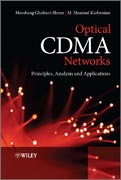
Optical CDMA networks: principles, analysis and applications
Ghafouri-Shiraz, Hooshang
Karbassian, M. Massoud
This book focuses heavily on the principles, analysis and applications of code-division multiple-access (CDMA) techniques in optical communication systems and networks.In this book, the authors intimately discuss modern optical networks and their applications in current and emerging communication technologies,evaluating the quality, speed and number of supported services. In particular, principles and fundamentals of optical CDMA techniques from beginner to advanced levels are heavily covered. Furthermore, the authors concentrate on methods and techniques of various encoding and decoding schemes and their structures, as well as analysis of optical CDMA systems with various transceiver modelsincluding advanced multi-level incoherent and coherent modulations with the architecture of access/aggregation networks in mind. Moreover, authors examine intriguing topics of optical CDMA networking, compatibility with IP networks, and implementation of optical multi-rate multi-service CDMA networks.Key features:Expanded coverage of optical CDMA networks, starts from principles and fundamentalsComprehensive mathematical modelling and analysis from signal to system levelsAddresses the applications of modern optical networking in the current and emerging communication technologiesGreater focus on advanced optical multi-level incoherent and coherent modulations, spreading codes, and transceiverdesignsDetailed hardware specifications, system-level block diagrams, and network nodes€™ functionalitiesThis book appeals to researchers, practicing engineers, and advanced students. It is a practical resource for readers with an interest in optical communications and networks. INDICE: List of Figures xiiiList of Tables xxvPreface xxviiAcknowledgements xxxiii1 Introduction to Optical Communications 11.1 Evolution of Lightwave Technology 11.2 Laser Technologies 31.3 Optical Fibre Communication Systems 41.4 Lightwave Technology in Future 71.5 Optical Lightwave Spectrum 71.6 Optical Fibre Transmission 91.7 Multiple Access Techniques 101.8 Spread Spectrum Communications Techniques 141.9 Motivations for Optical CDMA Communications 211.10 Access Networks Challenges 221.11 Summary 23References 242 Optical Spreading Codes 292.1 Introduction 292.2 Bipolar Codes 302.3 Unipolar Codes: Optical Orthogonal Codes 372.4 Unipolar Codes: Prime Code Families 412.5 Codes with Ideal In-Phase Cross-Correlation 622.6 Multidimensional Optical Codes 762.7 Channel Encoding in OCDMA Systems 842.8 Turbo-Coded Optical CDMA 1002.9 Summary 110References 1113 Optical CDMA Review 1153.1 Introduction 1153.2 Optical Coding Principles 1153.3 OCDMA Networking: Users Are Codes 1173.4 Optical CDMA Techniques 1193.5 Free-Space and Atmospheric Optical CDMA 1263.6 Summary 128References 1284 Spectrally Encoded OCDMA Networks 1334.1 Introduction 1334.2 Spectral-Amplitude-Coding Schemes 1344.3 System Considerations 1414.4 Gaussian Approach Analysis 1444.5 Negative Binomial Approach Analysis 1534.6 Spectral-Phase-CodingSchemes 1644.7 Summary 167References 1675 Incoherent Temporal OCDMA Networks 1715.1 Introduction 1715.2 PPM-OCDMA Signalling 1725.3 PPM-OCDMA Transceiver Architecture 1735.4 PPM-OCDMA Performance Analysis 1805.5 Discussion of Results1835.6 Overlapping PPM-OCDMA Signalling 1875.7 OPPM-OCDMA Transceiver Architecture 1885.8 OPPM-OCDMA Performance Analysis 196.9 Discussion of Results 2035.10 Analysis of Throughput 2095.11 Summary 211References 2116 Coherent TemporalOCDMA Networks 2136.1 Introduction 2136.2 Coherent Homodyne BPSK-OCDMA Architecture 2146.3 Coherent Heterodyne BPSK-OCDMA Architecture 2226.4 Summary 229References 2307 Hybrid Temporal Coherent and Incoherent OCDMA Networks 2317.1 Introduction 2317.2 Coherent Transmitter with Incoherent Receiver 2327.3 Analysis of Transceivers with MAI Cancellation 2357.4 Results and Throughput Analysis2397.5 Summary 244References 2448 Optical CDMA with Polarization Modulations 2458.1 Introduction 2458.2 Optical Polarization Shift Keying (PolSK) 2478.3 PolSK-OCDMA Transceiver Architecture 2548.4 Evaluation of PolSK-OCDMA Transceiver Performance 2638.5 Transceiver Architecture for Hybrid F-PolSK-OCDMA 2658.6 Performance of F-PolSK-OCDMA Transceiver 2738.7 Long-Haul PolSK Transmission 2738.8 Summary 278References 2789 Optical CDMA Networking 2819.1 Introduction 2819.2 OCDMA-PON 2899.3 OCDMA-PON Architecture 2909.4 IP Traffic over OCDMA Networks 2999.5 Random Access Protocols 3089.6 Multi-Protocol Label Switching 3309.7 Summary 342References 34410 Services Differentiation and Quality of Services in Optical CDMA Networks 34710.1 Introduction 34710.2 Differentiated Services in Optical CDMA 35110.3 Variable-Weight Optical Spreading Codes 35410.4 Variable-Length Optical Spreading Codes 36410.5 Multirate Differentiated Servicesin OCDMA Networks 37610.6 Summary 383References 384Index 387
- ISBN: 978-0-470-66517-6
- Editorial: John Wiley & Sons
- Encuadernacion: Cartoné
- Páginas: 432
- Fecha Publicación: 13/04/2012
- Nº Volúmenes: 1
- Idioma: Inglés
